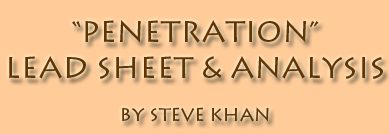Life is certainly full of surprises! Not exactly the most profound statement one could make, but, true it is. When I found out that
BGO Records(UK) was going reissue my first three albums as a leader, originally for Columbia Records in the late '70s, I was really thrilled, and very flattered. After the actual release in early 2015, I saw an opportunity to
pitch the idea to Andy Gray at BGO, to see if they would be remotely interested in doing a similar reissue of the three
Eyewitness recordings that
Anthony Jackson,
Steve Jordan,
Manolo Badrena, and I recorded between 1981-1983.
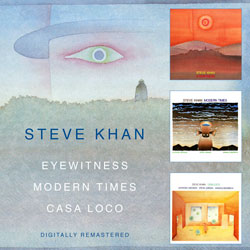
To better
sell the idea, I asked the brilliant graphic designer
Janet Perr to design several covers, all using the beautiful images of
Jean-Michel Folon as in the original LP/CD covers. Of course, we did these new designs in the customary BGO reissue style. And, in my opinion, the most appropriate of those designs now graces this reissue cover. For those of you who love the images and the body of work of Jean-Michel Folon, we created a page to share with everyone
Janet's Designs for this project. We all hope that those of you who still actually read and enjoy webpages will make that one extra click, and view these cover images.
As we have arrived at March/April of 2016, KORNER 2 has now shared almost all of the lead sheets for the music that we recorded during the
Eyewitness years. Only one tune remained, and it was the only tune that was a cover version that we recorded. And so, it only felt right that now, "
Penetration," originally recorded by
The Pyramids in 1963, should be the final presentation of that music. But, let's return to the concept of life's surprises for a moment. During the earlier part of this year, 2016, for some reason, I happened to watch a YouTube video of those same Pyramids performing "Penetration" on what appeared to be an installment of Dick Clark's
American Bandstand. In truth, I don't believe that I had actually heard the original version of this tune in decades. When our group began to rehearse it and perform it, I just taught it to the guys from memory. And, because the basic guitar figure, it seemed only logical that it had to have been played in F# minor, which gives one the full usage of the open E-string. And so, we just did it in that key. Guitarist
Tim Weston helped me out by reminding me of the melody, and changes to the bridge, and we seemed to be all set. Our recorded version that you now hear, and some of you are most familiar with, was performed that way, and reflects the brilliant musical sensibilities of Anthony, Steve and Manolo.
On a most frivolous side note, with their shaved heads, if the Pyramids had appeared and recorded this tune more recently, they might have been seen as lookalikes for the
Observers from the TV series, "
FRINGE"(2008-2013). But, The Pyramids were probably far too happy and animated to have ever been confused with the dour, sourpuss looks of any
Observer. Just sayin'!
However, back to the present, when I listened to that YouTube clip of the original version, something sounded strange to me. Firstly, I was struck by the melody of the bridge, the [
B] section. It was completely different, in register, and above all, I noticed that its melodic content amidst the broken chords was ascending, and not descending as I had played it - and always believed that it had been played that way. I brought my guitar over to my computer, and began to pluck out the melody, and was going to write it down just for comparison. Then, of all things, to my utter amazement, I realized that the original tune was played in the key G minor, and not in F# minor at all. Honestly, I had never known that the tune was in this key. Then, I said to myself, "How the heck did the 2nd guitarist play that figure in this key?" I kept looking at the video, but, because he was left-handed, and because of all the dance steps that they employed, I really couldn't see what he was doing. The only solution that made any sense to me, after great thought, was that he must have used his open D-string, as the lower notes would move back-and-forth between G and F. I sent Tim Weston an e-mail with the YouTube video link attached thinking that he would write me back shortly and tell me: "Well, of course, it's in G minor, didn't you know that?!?!?" But no, he told me that, like me, he had always thought that it was in F# minor too! So, we had a big laugh about that one. And now, to celebrate this most glorious discovery, I have transcribed and written the bridge out in the original key, and, if you care to, you can compare and contrast the two versions. You will find this transcription on Pg. 4 of the presentation.
Why don't we begin with Steve Jordan's contributions to this performance? At some point over the two days of recording, Steve had set-up his hybrid drum kit, one that included some real drums, and integrated amongst them were parts of a Simmons Electronic Drum Kit. It was a pretty remarkable concept. When attempting to record something like this for the 1st time, it requires some trial and error. It wasn't long before Steve and engineer
Doug Epstein had arrived at an acceptable balance, and "Penetration" became one of the first pieces that we recorded this way. Of course, Steve's choice of drum and cymbal sounds have now become legendary amongst other drummers, and musicians in general. For me, as I listen now, hearing his treatment of the [
B] section is really remarkable as he travels from an insistent quarter-note pulse, to a wild British type of feel with huge snare accents on both the and-of-2, and beat 4. All this is going on while Steve smashes the livin' crap out of what I recall was a "paper thin" Paiste cymbal that Steve used to refer to as his "Ringo" cymbal. The main thing is that it almost produces pure
white noise! It is an incredible sound. You couple these elements with his natural musical sense of extreme dynamics and unbridled energy, and you then have a truly unique performance by one of our great, great drummers!
Anthony and I, to my recollection, really had no conversations at all about what he was going to play on this tune, and I would imagine that, if pressed for an answer, he probably thought that Manolo, Steve, and I could not have possibly been serious about doing this. But, as you all now know, we were, and
very serious, but with a bit of a smile too!
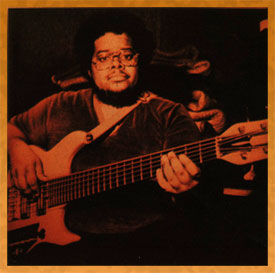
At this latter stage of life, for me, the two sections that really reveal the depth of Anthony Jackson's harmonic creativity are letters [
B] and [
B2], and the Fade, which I have labeled here on Pg. 3 as letter [
D]. How Anthony transforms the very simple harmonies of the [
B] sections is, for me, astounding. Taking, what could be, in other hands, the most basic major triads coming from the guitar, and turning them into quite a sequence, which provides its own kind of internal musical logic. During the 1st 8 bars, he goes from putting to use the b7 for each chord, but then, in the 2nd 8 bars, he plays a B pedal for the entire time through those same first 6 bars. It's so great, and I remember hearing these ideas at the rehearsals, and sensing that something special was happening, and would happen. Again, I said nothing, nor did I suggest any of this, it all came from Anthony!
To be perfectly honest with everyone, until just recently, while rewriting the lead sheet for our performance of this tune, I didn't recall that Anthony had treated the reprise of this section, which is now labeled as [
B2], in a completely different manner. I am mainly referring to bars 9-14. Remember that in the prior [
B] section, in these same bars, he had played a B pedal. This time, he begins each chord by playing the 3rd of the chord, before going to the b7. What can I say? It's just truly brilliant. If there's a lesson here for me and everyone else, it is that, sometimes you just have to allow your fellow musicians to carve out their path, and the results can be breathtaking - but, you have to allow it to happen. Other times, your own vision can be strong enough, and you have to follow that gut feeling.
As letter [
D], the Fade, arrives, once again, Anthony takes the piece to one last change of level, one that was equally unexpected, but so very unique. For this presentation, I had to sit down and transcribe what he played, as best as I could hear it. While using a similar rhythmic flow of constant 8th-notes, he ventures off into uncharted harmonic territories with this 2-bar
ostinato. Looking back at what I played, it would seem that I had thought that we could in an area of E/F# or C#m7/F#, or an F#m7(9sus) kind of feeling. Somehow, it all works together. Though, for this webpage, I chose to use the sepia tone photo of Anthony that appeared on the "
EYEWITNESS" album from 1981, and, in this photo, he is seen with one of his first 6-string contrabass guitar prototypes from Ken Smith, he only took a photo with it, and never played it on that album, stating that, "it wasn't ready yet." So, he was still playing his trusty old Fender Precision Bass with the natural wood finish - a beautiful instrument that always sounded fantastic because of Anthony's touch on the instrument, and his concepts about making music.
As I have written and said before, many times, the spontaneous imagination of Manolo Badrena, and all of his percussive colors has been a huge ingredient in every concoction that we, as a group, ever cooked up. Though Manolo was born and raised in Puerto Rico, and certainly knows from beaches and the culture of the ocean and its waves, I did give him a few little bits and pieces of California surfing lingo, and, in his own way, Manolo adds those "authentic" flavors to the mix. If you listen closely, you can hear them throughout the piece. Just out in front of the downbeat, you hear him say: "For sure man....." and then, "Hey, the surf is up baby!" All given to us with his characteristically wacky laugh. All those wild sounds that you hear darting in and out, they were all created by Manolo. The thing that sounds like an electric xylophone? That's him too, created by his electronic
Pearl Syncussion set-up!!!
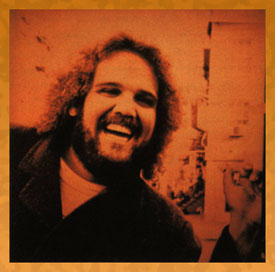
All the sounds of the "surf" that you hear? That's Manolo too, and the Syncussion device! Then, out of nowhere, there can be the sounds of Latin music from his timbal or a tap on a conga. When we recorded this tune, for some reason, in a moment of
down time insanity, engineer Doug Epstein happened to solo Manolo's performance, and just listening to it as
a work of art, I begged him to please make me a cassette of just that -
only Manolo's tracks. I have saved that cassette for years, decades, and occasionally, just for fun, I have unearthed it, and listened to it. It is still totally incredible to be allowed to hear his imagination at work. It makes me smile and laugh every single time. Now, this link allows you to hear a portion of it.
Over the many years that have passed since 1983, I have been asked about the guitar sounds that I used on the "CASA LOCO" album in general. The fundamental guiding principle for me, after the Columbia years(1977-1979) was to go back to a more
pure and simple guitar sound. In essence, that was to be a Gibson ES-335 guitar played direct into an amp, and with only a little reverb for treatment. Of course, as the music developed from 1981 forward, I had to be more flexible about that, and a Fender Stratocaster appeared on some tunes as well. As the music for this particular album evolved, it just seemed that, once again, certain sections were going to need a little something
extra, and so, on this album, that sound was produced with the help of the very primitive
Ibanez Chorus(CS9). This particular pedal was a bit noisy sounding, not ideal for a high-quality audio recording, but it was in stereo, and was played through a pair Roland JC-120s. "Penetration" turned out to be one of the Strat tunes on this album. I have to assume, because of the year, that I was still using my 'real' Fender Strat, and for this tune, it sounds like I was using that
in-between sound that comes from combining the middle pick-up with the neck pick-up. The overdrive sounds that you hear in the [
B] sections, were probably played live on the Strat with the help of an
Ibanez Tube Screamer TS-9. But, I would imagine that I replaced all those little sections via overdub, and then using the bridge pick-up of my 335, and just playing really, really, really
LOUD!!! From 1990 to the present, the major sonic difference is that then I had graduated to, what became my true voice, where effects are concerned, the
Ibanez Digital Chorus/Flanger(DCF-10), which I have written about extensively at the
EQUIPMENT page here.
The spirit of cooperation between
Anthony Jackson;
Steve Jordan;
Manolo Badrena and me provided us with so much hope. Here we mixed elements of Surf, Rock, Jazz, World music, Latin music, and probably other things that I can't think of right now. Many innovative things happened during our years together, and "CASA LOCO," the album, is a real high-water mark for both hybrid drum and percussion set-ups, ones that integrate highly creative and inventive electronic sounds, that rarely appeared again in the context of instrumental music with the beautiful natural sounds of drums and percussion. All three of these great players are innovators, and they were brilliant on these albums, and their performances are to be treasured! The BGO Records reissue, here in 2016, gives everyone a wonderful opportunity to now own the three albums on CD forever. Those of you who missed them, or never heard them the first time around, this is your chance too to catch-up!!! Go for it!!!
With 20-20 hindsight, it is a bit remarkable that we would even put a piece like "Penetration" on a recording, but, in balance, there is just something so very different about the way that a tune like this come across. Now, all these years later, the renowned French Jazz journalist,
Frédéric Goaty, under the very clever
nom de plume of
Peter Cato,
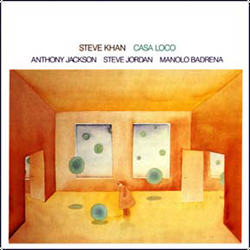
wrote a fantastic piece about
Eyewitness for
Muziq Magazine, one that celebrates the 3 albums by our group, and the perceived musical relationship to the great, great band, The Police. If people heard things that way, in the end, it was a most flattering honor for us, because it was not intentional on our part at all. And now, in the most recent issue of
Muziq, we have a most spectacular review of the BGO reissue, written by
Doc Sillon, just click on this link and enjoy it. But only, of course, if you can read in French!!!
In the end, I suppose the Jazz purist, or even the Jazz-Fusion purist could ask, "What is a surfing classic doing on an album like this?" Good question, perhaps even a fair question. But, one must not forget that I grew-up in Los Angeles, California, and not too far from the beach, and from surfing and surfers, though I was never one of them. However, I did love instrumental music, and grew to love the surfing music from the late '50s and early '60s. And, by now, most people know that I was the drummer in the 2nd incarnation of The Chantays, of "Pipeline" fame! So, in my way, I am deeply connected to this music. Honestly though, I never would have thought that I would have been recording a piece of music like "Penetration" - NEVER!!! But, in all the time spent at our crazy, laugh-filled rehearsals, we tried out this tune one day, and the creative brilliance from Anthony, Steve, and Manolo flowed, and the piece stayed in our repertoire. Now, when I listen to this performance, I am astonished by the way that these three great players took a simple tune like this, and transformed it into something else, giving it an insanely timeless quality. I think that if, our listeners from the past, and our new ones from the present, just suspended all sense of genres and labels, they might find this to be a wild ride! I need not remind everyone that a revered guitarist like
Pat Metheny has recorded "Pipeline"! And, another visionary guitarist,
Bill Frisell has recorded "
Pipeline" too, not to mention tunes like: "Rumble"; "Telstar"; "Surfer Girl"; and "In My Room" - all music from that mindset, and place in time!
So, just what kind of music is this?!?!?! Well, it's certainly NOT
Jazz!!! But, the spirit of improvisation, invention, interaction, conversation and energy are all there. Does music need a category, or a genre label? To musicians, absolutely not - it's just music. But, to those who bring the music to the people, those genre labels or categories are essential. They are the marketing people. And, for better or worse, we, the musicians, need them. However, with the disappearance of the record store, the CD stores, where there had to be 'sections' so that the shopper/music fan could locate his or her favorite recordings, dividing the space into genres and categories made perfect sense. It also makes sense for those who program radio stations. Does someone's music have to fit into their format? Honestly, I have NO IDEA just what kind of music "Penetration" is, beyond the fact that it is a surfing music classic! It certainly does have a kind of zany attitude, one that is really different for non-singing music, and if given the opportunity, I wouldn't hesitate from recording such a tune again, because the fun is in not knowing what might happen. It is like walking on a tightrope over a gorge without a safety net, and I think that, as a group, we all liked that sense of risk too!!! Thanks to everyone who has enjoyed this ride with the four of us between 1981-1985, it was our pleasure to have you along!!! To any new fans that the reissue might have added, we are all thrilled to have you on board! Welcome!!!
